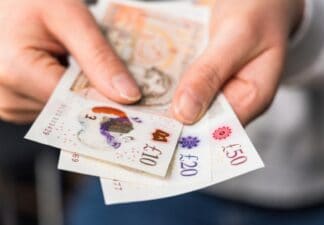Royal Bank of Scotland Group (LSE: RBS) (NYSE: RBS.US) has agreed a deal that will end the government’s priority right over dividend payments.
The trouble is, I don’t think it matters much — and judging from the lack of movement in RBS’s share price this morning, City investors aren’t impressed either.
DAS = IOU
 Here’s a quick recap of this morning’s news. The UK government’s £45bn bailout of RBS included a ‘dividend access share’, or DAS. The DAS gave the government priority rights over future dividend payments, preventing any other shareholders receiving dividends until the DAS was removed.
Here’s a quick recap of this morning’s news. The UK government’s £45bn bailout of RBS included a ‘dividend access share’, or DAS. The DAS gave the government priority rights over future dividend payments, preventing any other shareholders receiving dividends until the DAS was removed.
According to today’s announcement, RBS will pay £320m to the Treasury this year, followed by £1.18bn in future instalments, in order to cancel the DAS. This should help pave the way for the government to sell its stake in RBS, and for the bank to restart dividend payments to ordinary shareholders.
Profits, where are they?
RBS shouldn’t have any difficulty affording this year’s £320m payment to the Treasury, but the remaining £1.18bn could be more of a challenge.
After all, RBS needs to make some profits from which it can pay dividends. Current City consensus forecasts indicate that RBS is expected to make post-tax profits of £2.33bn in 2014, some of which might reasonably be used to help pay down the DAS.
However, RBS also needs to continue to strengthen its balance sheet. Its Common Equity Tier 1 (CET1) ratio, a key regulatory measure, was just 8.6% at the end of 2013 — above the minimum regulatory threshold of 7%, but substantially below its 2015 target of 11%. Lloyds, in contrast, reported a CET1 ratio of 10.3% at the end of 2013.
What’s more, analysts have ratcheted down their earnings forecasts for RBS by 11% over the last 3 months: if this trend continues, the bank might not make very much profit this year.
Fully priced already?
In my opinion, RBS already looks a bit pricey. The bank’s shares trade on a 2014 forecast P/E of 15.4, compared to 10.9 for Lloyds and 8.6 for Barclays.
Based on today’s announcement, I don’t expect RBS to pay an ordinary dividend until 2016. Although RBS still trades at a hefty discount to book value, its state ownership adds too much risk for me — after all, at some point, the government has got to find private buyers for £28bn of RBS stock!







